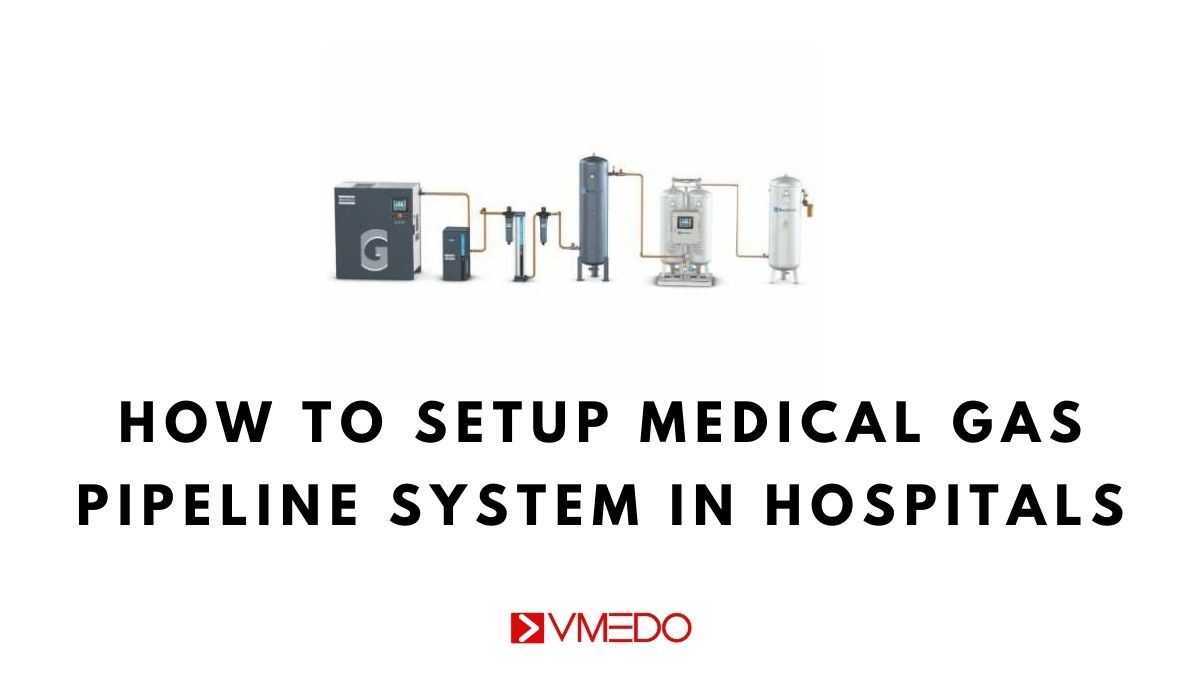Medical gas pipeline system is used in Hospitals for easy and efficient usage of Medical gases for clinical purposes. To setup, a medical gas pipeline click the link below and enquire or call 7406000610 for further assistance.
What is medical gas pipeline system?
There will be a centralized system of gas storage which will supply gases to different areas of the hospital according to the need. Since using high-pressure cylinders of medical gases proved to be unsafe and costly. The majority of the hospitals have shifted to a centralized system in which pressure can be monitored and controlled much efficiently.
There are varieties of Medical gases depending on various functions of healthcare; we’ve listed below the major types of gases of the medical gas pipeline system.
Major gases present in Medical gas pipeline system
- Oxygen
- Nitrous oxide
- Medical air 400 KPa
- Medical air 700 KPa
- Carbon dioxide (CO2)
- Nitrogen
- Medical Vacuum
Role of oxygen in the Medical gas pipeline system?
Oxygen is the life-sustaining gas on the planet; more than 21% of the earth’s atmosphere is filled with it. In medical gas pipeline oxygen is used to drive anesthesia machines and Ventilators. Oxygen is denoted in the color white in a medical gas pipeline system.
Role of Nitrous oxide in Medical gas pipeline system?
Nitrous oxide is used via an anesthesia machine; it gets mixed with oxygen and other gases while operating. Due to its purpose, nitrous oxide outlets are always put only in operation theatres. Cylinders and pipeline of Nitrous oxide are always denoted by Blue color.
Role of Medical air 4 bar in Medical gas pipeline system?
Medical air is also used mainly for respiratory purposes. It’s either supplied by Intake manifold or compressor system. Medical air is always represented by Alternative White and Black stripes
Role of Medical air 7 bar in Medical gas pipeline system?
Slightly higher pressure on Medical air is also used in the medical gas pipeline system. It is used in applications where pneumatic devices such as a Bone saw and Tourniquet are used. Even this Medical air is represented by Alternative White and Black stripes.
Role of Carbon dioxide in Medical gas pipeline system?
Carbon dioxide is used for insufflation purposes during open heart and other important surgeries. Carbon dioxide is also used in Laparoscopy procedures. Usually, carbon dioxide pipes are painted with Grey color.
Role of Nitrogen gas in Medical gas pipeline system?
Nitrogen is used in Medical gas pipelines to majorly drive gas-powered tools such as surgical tools, cutters, and saw. Nitrogen is usually supplied by compressors. The pipe which carries nitrogen gas is color-coded with black color
Role of Medical vacuum in Medical gas pipeline system?
A vacuum is used to drive suction related machines in any hospital. The negative pressure generated by Vacuum gets utilized in the anesthetic scavenging system. Vacuum pipes are coded with yellow color for better identification.
Components of a medical gas pipeline system?
There are multiple components used in a medical gas pipeline system. The number of components used depends on the size and design of the structure.
The main components are,
- Sources
- Piping networks
- Inlets, Outlets
- Valves
- Warning and alarm systems
- Secondary equipment
Sources are supplies that drive the pipeline system. There are different types of sources as per the gases involved.
The major types of sources include,
Bulky systems are constructed as large high-pressure manifolds or cryogenic tanks. They are usually made up of specially insulated vessels, vaporizers, and regulators.
It consists of high-pressure cylinders to supply gases. The main control panel is fixed on the manifold to regulate the pressure.
Medical air treatment systems are usually equipped with compressors, pressure monitors, regulators, filters, dehumidifiers, and dew point monitors so that the air supplied is free of dust and moisture.
Vacuum pumps are used for the suction line, they are used to derive negative pressure to operate various machines at the outlet. A Negative pressure around the rate of 53 KPA is required at all times from a vacuum pump.
Medical gases and vacuum are transmitted throughout the structure through the help of pipes. Pipes used in the medical gas pipeline are made of high-quality copper or stainless steel so that the process of corrosion doesn’t occur. These pipes are color-coded and maintained frequently for effective utilization.
Valves are used to drive gases through the pipeline to various outlets. The main function of valves in a medical gas pipeline system is to stop the flow of gases during service. There are two types of valves, namely, service valves and zone valves which are used in different situations to shut off the flow of medical gases.
Outlet points are used to connect the medical gases with service applications such as ventilators or Anesthesia machines. Inlets are used for vacuum pipeline. Outlets are also supposed to be color-coded for effective usage
- Secondary equipment.
Although Equipment such as hoses, Pressure regulators, and flow meters doesn’t make up the primary system, they are essential for the smooth operation.
How to setup medical gas pipelines in Hospitals.
The process of medical gas pipeline happens at different levels, namely Planning, Scheduling, Design, Simulation, Procurement, Fabrication, Installation, Testing, Review, and Operation.
We’re mainly going to talk about the design aspect of the Medical gas pipeline system in this article,
- We need to analyze the different parts of the Hospital to identify
- Location and numbers of inlet-outlet?
- Which are the different gases required?
- Which type of inlet-outlet system is beneficial for the hospital staff?
- Devices that are being utilized in the hospital and their requirement etc…
- Analyze the construction plan properly; expansion of the building should be taken into account. (Vertical or Horizontal Expansion)
- Determine the locations for various gas systems.
- Determine the schematic design for valves, inlet-outlets, etc…
- Medical gases should be independent of other possible gas pipelines such as labs and manufacturing units in an organization.
- Design medical gas pipeline to maintain a steady pressure across the structure.
- Define total flow for different gases.
- Define flow rates at each terminal and make sure they can be varied.
- Make sure all the sources are provided with a backup in case of emergency
- Electrical back-up should also be considered before moving on to the installation
Medical gas pipeline system standards
ISO 7361-1:2007 specifies the requirement for design, installation, and maintenance of the medical gas pipeline, compressed medical gases, or gas-powered tool operation.
It specifies guidelines in the design, construction, inspection, and operation of healthcare facilities treating human beings. Those who are in charge of manufacturing and testing of equipment intended to be connected to pipeline system must also use this policy as guidelines
ISO 7361-1:2007 also seeks to ensure that medical gas pipelines contain only the specific gases intended to be supplied.
The objectives of this part of ISO 7396 are to ensure the following.
- Non- Interchangeability between pipeline systems by design
- Continuous supply of gases and vacuum at specified pressures by providing appropriate sources
- Use of suitable materials
- Cleanliness of components
- Correct installation
- Provision of monitoring and alarm systems
- Correct marking of the pipeline system
- Testing, commissioning, and certification
- The purity of the gases delivered by the pipeline system
- Correct operational management
References
1. K. G. Wentink, and R.D. Jackson “, Medical gas and vacuum systems,” Plumbing Systems & Design, January/February 2006, pp: 44-53.
2. J. Dyro, “The clinical Engineering handbook”, Elsevier Press, NYK, 2004, pp: 537- 540.
3. “Medical vacuum and gas systems”, The University of Texas, MD Anderson Cancer Center, 2010.
4. DH Estates and Facilities Directorate, “Health technical memorandum 02-01: Medical gas pipeline systems – Part A design, installation, validation, and verification”, May 2006.
5. DH Estates and Facilities Directorate, ” Health technical memorandum 02-01: Medical gas pipeline systems – Part B operational management”, May 2006.
6. International standard ISO 7361-1 Second edition, 2007-04-01



